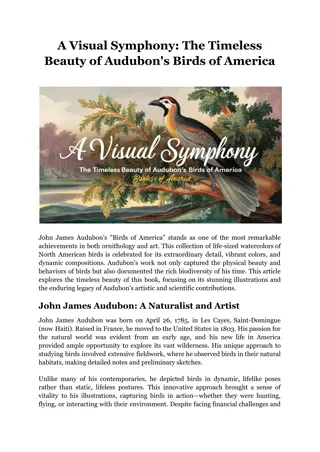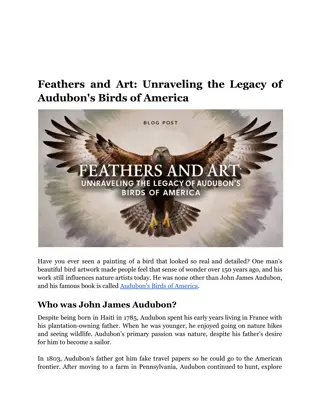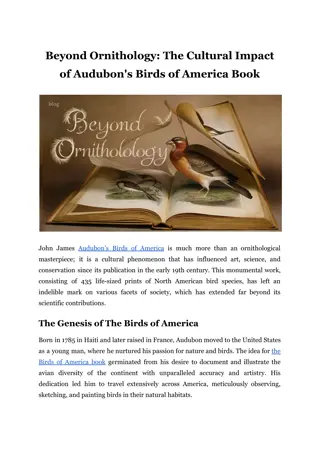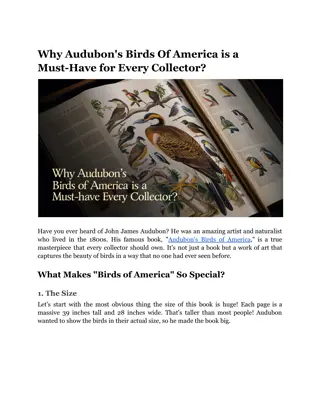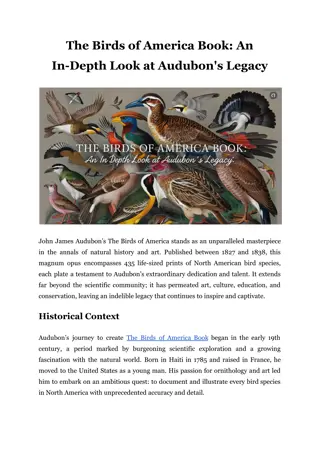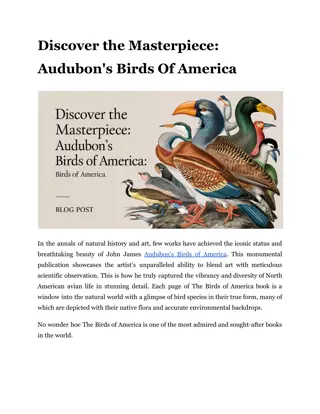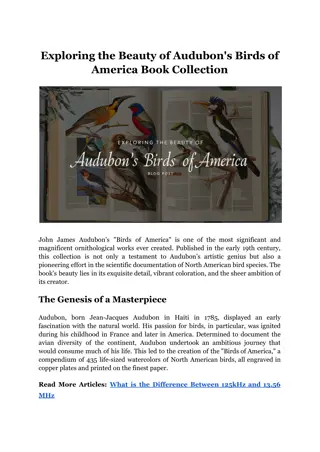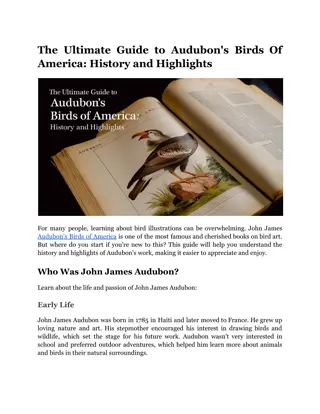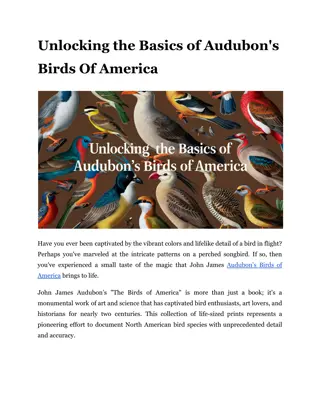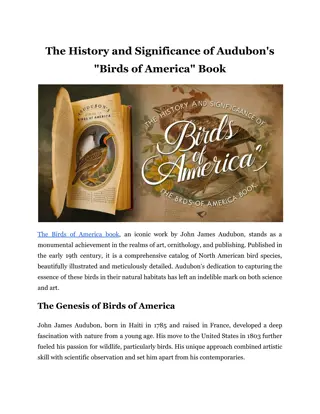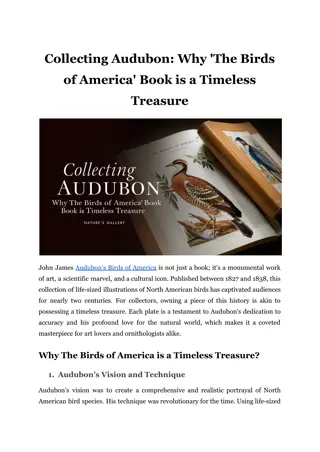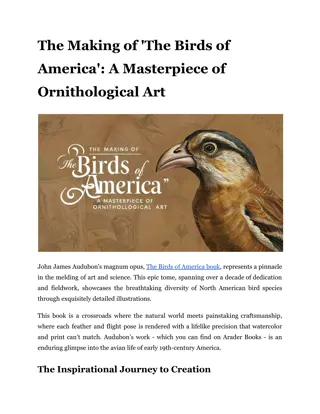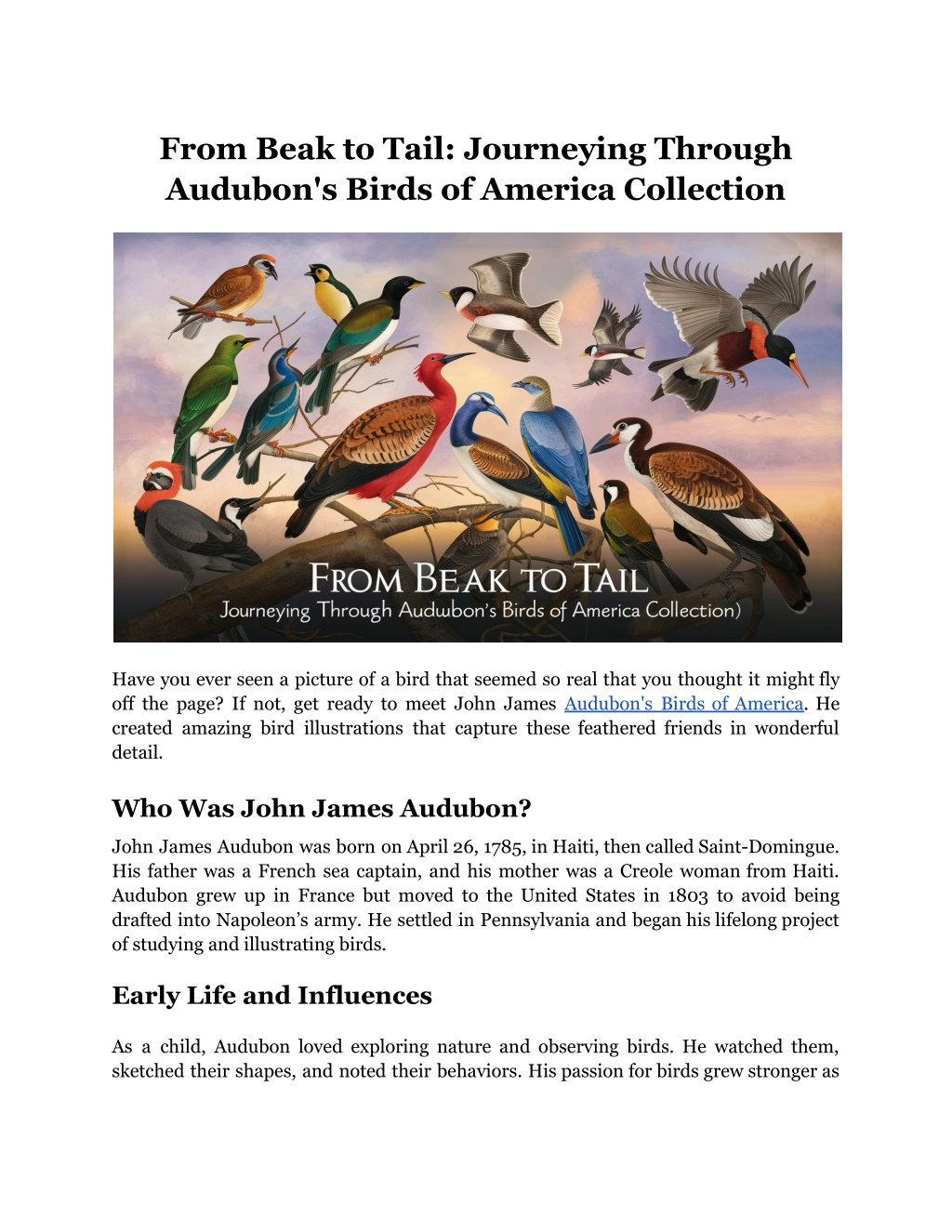
From Beak to Tail_ Journeying Through Audubon's Birds of America Collection
Explore John James Audubon's "Birds of America" collection - a stunning journey through the avian world from feathers to flight!
Download Presentation

Please find below an Image/Link to download the presentation.
The content on the website is provided AS IS for your information and personal use only. It may not be sold, licensed, or shared on other websites without obtaining consent from the author. Download presentation by click this link. If you encounter any issues during the download, it is possible that the publisher has removed the file from their server.
E N D
Presentation Transcript
From Beak to Tail: Journeying Through Audubon's Birds of America Collection Have you ever seen a picture of a bird that seemed so real that you thought it might fly off the page? If not, get ready to meet John James Audubon's Birds of America. He created amazing bird illustrations that capture these feathered friends in wonderful detail. Who Was John James Audubon? John James Audubon was born on April 26, 1785, in Haiti, then called Saint-Domingue. His father was a French sea captain, and his mother was a Creole woman from Haiti. Audubon grew up in France but moved to the United States in 1803 to avoid being drafted into Napoleon s army. He settled in Pennsylvania and began his lifelong project of studying and illustrating birds. Early Life and Influences As a child, Audubon loved exploring nature and observing birds. He watched them, sketched their shapes, and noted their behaviors. His passion for birds grew stronger as
he got older. Unlike many scientists of his time who drew birds in stiff, unnatural poses, Audubon wanted to show them full of life and movement. Read More Articles: Why Hire A Concrete Boom Pump In Construction Projects The Making of Birds of America Creating Birds of America was a huge task that took many years. Audubon traveled thousands of miles, spent countless hours in the field, and worked very hard to bring his vision to life. Here s how he did it. Field Studies and Observations Audubon went on long trips across North America, from the swamps of Florida to the forests of the Midwest. He faced tough weather, dangerous animals, and challenging landscapes. However, he was determined to study birds in their natural habitats. He kept detailed journals and made sketches of the birds he saw, capturing every detail of their appearance and behavior. Artistic Process To create his illustrations, Audubon used a method called "shotgunning" to collect birds. He would then pose them with wires to make them look like they were alive and active. This way, he could draw them in natural, dynamic poses. Audubon used watercolor paints and pastels to add color, and he used pencils and ink to add fine details. His goal was to make the birds look as lifelike as possible. Publishing Challenges Finding a publisher for The Birds of America book was not easy. Audubon wanted the book to be large enough to show the birds life-sized, which was very ambitious. After many rejections in the United States, he went to Europe. In Edinburgh, Scotland, he found a publisher willing to take on the project. The first edition of Birds of America was printed between 1827 and 1838. Birds of America: The Collection Birds of America includes 435 hand-colored, life-sized prints of 497 bird species. Each illustration is known for its accuracy, detail, and artistic quality. Here are some highlights from this incredible collection.
The Beauty of the Illustrations Audubon s illustrations are more than just scientific drawings they are works of art. Each bird is shown in a natural pose, often interacting with plants, insects, or other parts of its environment. The colors are vivid, and the details are so precise that you can see every feather. These illustrations are not only beautiful but also provide a lot of information about the birds appearances and behaviors. Notable Birds in the Collection 1. American Flamingo: This bright pink bird is shown with its long neck curved gracefully as it feeds in shallow water. The detailed feathers and the elegant pose make it one of the most striking images in the collection. 2. Carolina Parakeet: This colorful bird, which is now extinct, is shown perched on a branch. Its green, yellow, and orange feathers are beautifully rendered, capturing the bird s lively personality. 3. Great Blue Heron: This tall, majestic bird is depicted in mid-stride, with its long legs and neck elegantly extended. The illustration shows every detail of its feathers, highlighting Audubon s skill in portraying movement and texture. Scientific Contributions Audubon s illustrations were not just beautiful; they were also scientifically important. He documented many bird species for the first time and provided detailed descriptions of their behaviors and habitats. His work helped scientists understand the diversity of bird life in North America and provided a foundation for future studies in ornithology. Impact and Legacy Audubon s Birds of America had a huge impact on both science and art. Its influence is still felt today in many ways.
Influence on Ornithology Audubon s careful observations and detailed illustrations set new standards in the study of birds. His work provided a lot of new information about bird species that were not well understood before. Scientists and bird enthusiasts used his book as a key reference for many years. Audubon s approach to studying birds in their natural habitats also inspired future generations of ornithologists. Artistic Legacy Audubon s work influenced many artists who came after him. His ability to capture the essence of birds in their natural settings set a new standard for wildlife art. Artists admired his attention to detail and his commitment to showing birds as they are. Today, his work is displayed in museums and art collections around the world, inspiring both artists and nature lovers. Artistic Inspiration Audubon s work continues to inspire artists around the world. His ability to combine scientific accuracy with artistic beauty serves as a model for creating nature art. Many wildlife artists look to Audubon s illustrations as examples of how to capture the essence of their subjects. Read More Articles: Understanding the Distinctions: Proximity Cards vs. RFID Technology Digital Access Thanks to digital technology, Birds of America is more accessible than ever before. High-resolution images of the prints are available online, allowing people from all over the world to explore Audubon s work in detail. This digital access helps to preserve the collection and makes it easy for anyone to enjoy and learn from Audubon s remarkable illustrations. Conclusion John James Birds of America is a masterpiece of both art and science. Audubon s dedication to his work and his passion for nature have left a lasting legacy that continues to inspire and educate people around the world.
At Arader Books, we are proud to be your top choice for the finest editions of Audubon's Birds of America along with a wide variety of other exceptional books. Visit us today to discover great deals on your favorite titles! Site Article: From Beak to Tail: Journeying Through Audubon's Birds of America Collection


